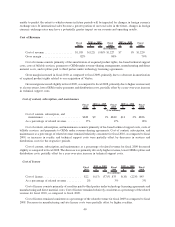Symantec 2010 Annual Report Download - page 106
Download and view the complete annual report
Please find page 106 of the 2010 Symantec annual report below. You can navigate through the pages in the report by either clicking on the pages listed below, or by using the keyword search tool below to find specific information within the annual report.actual results differ from these estimates and other considerations used in estimating amounts reflected in the
Consolidated Financial Statements included in this annual report, the resulting changes could have a material
adverse effect on our Consolidated Statements of Operations, and in certain situations, could have a material
adverse effect on liquidity and our financial condition.
A critical accounting estimate is based on judgments and assumptions about matters that are uncertain at the
time the estimate is made. Different estimates that reasonably could have been used or changes in accounting
estimates could materially impact the operating results or financial condition. We believe that the estimates
described below represent our critical accounting estimates, as they have the greatest potential impact on our
consolidated financial statements. See also Note 1 of the Notes to the Consolidated Financial Statements included in
this annual report.
Revenue Recognition
We recognize revenue in accordance with generally accepted accounting principles that have been prescribed
for the software industry. We recognize revenue primarily pursuant to the requirements under the authoritative
guidance on software revenue recognition, and any applicable amendments or modifications. Revenue recognition
requirements in the software industry are very complex and require us to make many estimates.
For arrangements that include multiple elements, including perpetual software licenses and maintenance
and/or services, packaged products with content updates, managed security services, and subscriptions, we allocate
and defer revenue for the undelivered items based on vendor specific objective evidence (“VSOE”) of the fair value
of the undelivered elements, and recognize the difference between the total arrangement fee and the amount
deferred for the undelivered items as revenue. Our deferred revenue consists primarily of the unamortized balance
of enterprise product maintenance, consumer product content updates, and arrangements where VSOE does not
exist, such as managed security services and subscriptions. Deferred revenue totaled approximately $3.2 billion as
of April 2, 2010, of which $371 million was classified as Long-term deferred revenue in the Consolidated Balance
Sheets. VSOE of each element is based on the price for which the undelivered element is sold separately. We
determine fair value of the undelivered elements based on historical evidence of our stand-alone sales of these
elements to third parties or from the stated renewal rate for the undelivered elements. When VSOE does not exist for
undelivered items, the entire arrangement fee is recognized ratably over the performance period. Changes to the
elements in a software arrangement, the ability to identify VSOE for those elements, the fair value of the respective
elements, and increasing flexibility in contractual arrangements could materially impact the amount recognized in
the current period and deferred over time.
For arrangements that include both software and non-software elements that are within the scope of the newly
adopted accounting standards, further described below under “Recently Adopted Authoritative Guidance”, we
allocate revenue to the software deliverables as a group and non-software deliverables based on their relative selling
prices. In such circumstances, the new accounting principles establish a hierarchy to determine the selling price to
be used for allocating revenue to deliverables as follows: (i) VSOE, (ii) third-party evidence of selling price (“TPE”)
and (iii) best estimate of the selling price (“ESP”). When we are unable to establish selling price using VSOE or
TPE, we use ESP to allocate the arrangement fees to the deliverables.
For our consumer products that include content updates, we recognize revenue and the associated cost of
revenue ratably over the term of the subscription upon sell-through to end-users, as the subscription period
commences on the date of sale to the end-user. We defer revenue and cost of revenue amounts for unsold product
held by our distributors and resellers.
We expect our distributors and resellers to maintain adequate inventory of consumer packaged products to
meet future customer demand, which is generally four or six weeks of customer demand based on recent buying
trends. We ship product to our distributors and resellers at their request and based on valid purchase orders. Our
distributors and resellers base the quantity of orders on their estimates to meet future customer demand, which may
exceed the expected level of a four or six week supply. We offer limited rights of return if the inventory held by our
distributors and resellers is below the expected level of a four or six week supply. We estimate future returns under
these limited rights of return in accordance with the authoritative guidance on revenue recognition. We typically
offer liberal rights of return if inventory held by our distributors and resellers exceeds the expected level. Because
30
























